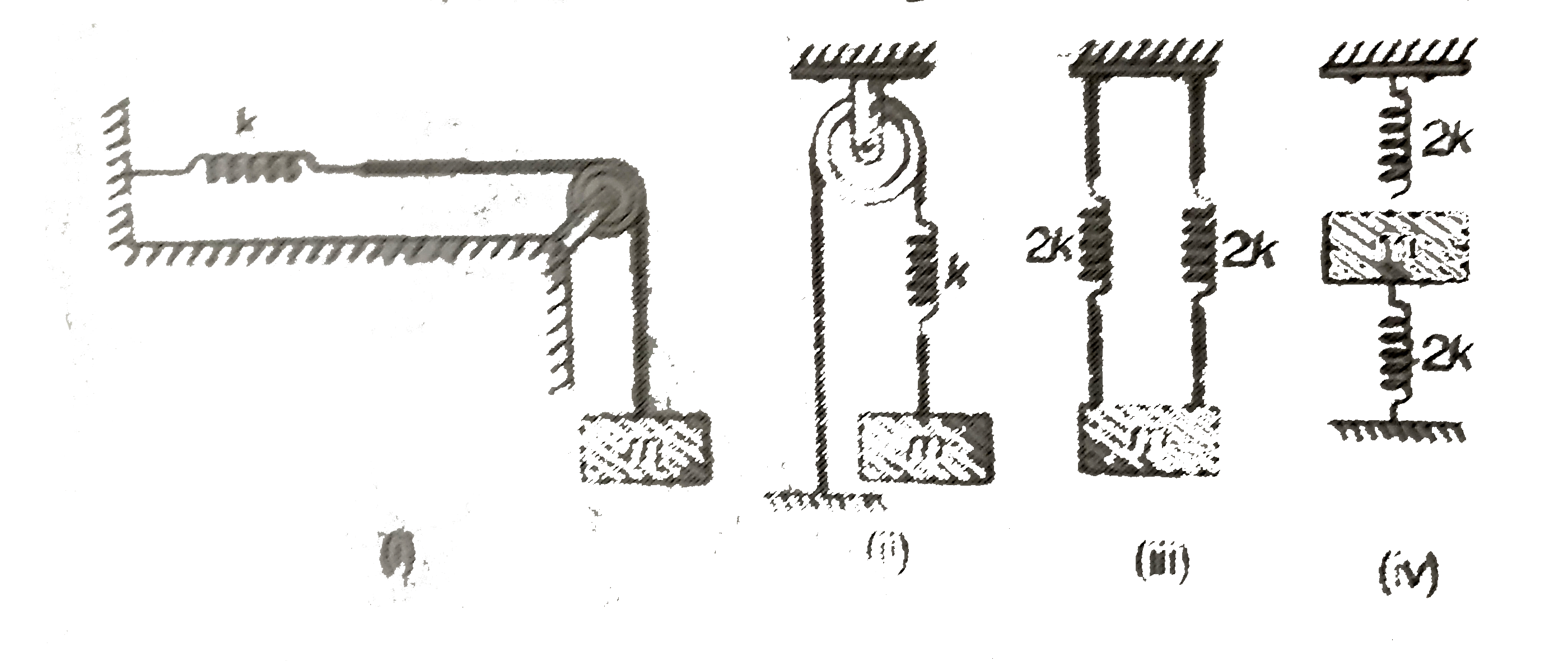The frequency f of vibrations of a mass m suspended from a spring of spring constant k is given by f=Cmxky , where C is a dimensionnless constant. The values of xandy are, respectively,
12,12
−12,−12
12,−12
−12,12
The correct Answer is:D
To solve the problem, we need to find the values of x and y in the equation for frequency f=Cmxky, where C is a dimensionless constant, m is mass, and k is the spring constant.
1. Identify the dimensions of frequency f:
The frequency f has dimensions of time inverse, which can be represented as:
(f)=T−1
2. Identify the dimensions of mass m:
The mass m has the dimension:
(m)=M1
3. Identify the dimensions of spring constant k:
The spring constant k is defined as force per unit length. The dimension of force is given by:
(Force)=(mass)×(acceleration)=M1L1T−2
Therefore, the dimension of spring constant k is:
(k)=(F)(L)=M1L1T−2L1=M1T−2
4. Write the dimensions of the equation:
Substituting the dimensions of m and k into the equation f=Cmxky:
(f)=(C)(m)x(k)y
Since C is dimensionless, we have:
(f)=(m)x(k)y=(M1)x(M1T−2)y=Mx+yT−2y
5. Set up the equations based on dimensions:
Now we equate the dimensions from both sides:
- For mass M:
x+y=0(1)
- For time T:
−2y=−1(2)
6. Solve the equations:
From equation (2), we can solve for y:
−2y=−1⟹y=12
Now substitute y back into equation (1):
x+12=0⟹x=−12
7. Final values:
Thus, the values of x and y are:
x=−12,y=12
Conclusion:
The values of x and y are −12 and 12, respectively.
The frequency f has dimensions of time inverse, which can be represented as:
(f)=T−1
The mass m has the dimension:
(m)=M1
The spring constant k is defined as force per unit length. The dimension of force is given by:
(Force)=(mass)×(acceleration)=M1L1T−2
Therefore, the dimension of spring constant k is:
(k)=(F)(L)=M1L1T−2L1=M1T−2
Substituting the dimensions of m and k into the equation f=Cmxky:
(f)=(C)(m)x(k)y
Since C is dimensionless, we have:
(f)=(m)x(k)y=(M1)x(M1T−2)y=Mx+yT−2y
Now we equate the dimensions from both sides:
- For mass M:
x+y=0(1)
- For time T:
−2y=−1(2)
From equation (2), we can solve for y:
−2y=−1⟹y=12
Now substitute y back into equation (1):
x+12=0⟹x=−12
Thus, the values of x and y are:
x=−12,y=12
The values of x and y are −12 and 12, respectively.
Topper's Solved these Questions
- DIMENSIONS & MEASUREMENTBook:CENGAGE PHYSICS ENGLISHChapter:DIMENSIONS & MEASUREMENTExercise:Multiple Correct
Explore 2 Videos
- DIMENSIONS & MEASUREMENTBook:CENGAGE PHYSICS ENGLISHChapter:DIMENSIONS & MEASUREMENTExercise:Linked Comprehension
Explore 3 Videos
- DIMENSIONS & MEASUREMENTBook:CENGAGE PHYSICS ENGLISHChapter:DIMENSIONS & MEASUREMENTExercise:Subjective
Explore 31 Videos
- CENTRE OF MASSBook:CENGAGE PHYSICS ENGLISHChapter:CENTRE OF MASSExercise:INTEGER_TYPE
Explore 1 Video
- FLUID MECHANICSBook:CENGAGE PHYSICS ENGLISHChapter:FLUID MECHANICSExercise:INTEGER_TYPE
Explore 1 Video
Similar Questions
Knowledge Check
A body of mass 20 g connected to a spring of spring constant k, executes simple harmonic motion with a frequency of (5/π) Hz. The value of spring constant is
A4Nm−1B3Nm−1C2Nm−1D5Nm−1
The frequency of oscillations of a mass m connected horizontally by a spring of spring constant k is 4 HZ. When the spring is replaced by two identical spring as shown in figure. Then the effective frequency is

View SolutionTwo particles (A) and (B) of equal masses are suspended from two massless spring of spring of spring constant k1 and k2, respectively, the ratio of amplitude of (A) and (B) is.
View SolutionThe spring force is given by F=−kx, here k is a constant and x is the deformation of spring. The F−x graph is
View SolutionTwo springs of spring constantsK1 and K2 are joined in series. The effective spring constant of the combination is given by
View SolutionTwo springs of spring constantsK1 and K2 are joined in series. The effective spring constant of the combination is given by
View SolutionWhen a mass of 5 kg is suspended from a spring of negligible mass and spring constant K, it oscillates with a periodic time 2π. If the mass is removed, the length of the spring will decrease by
View SolutionIf xy=k, where k is a constant and y=21, when x=6, what is the value of y when x=9?
View Solution
